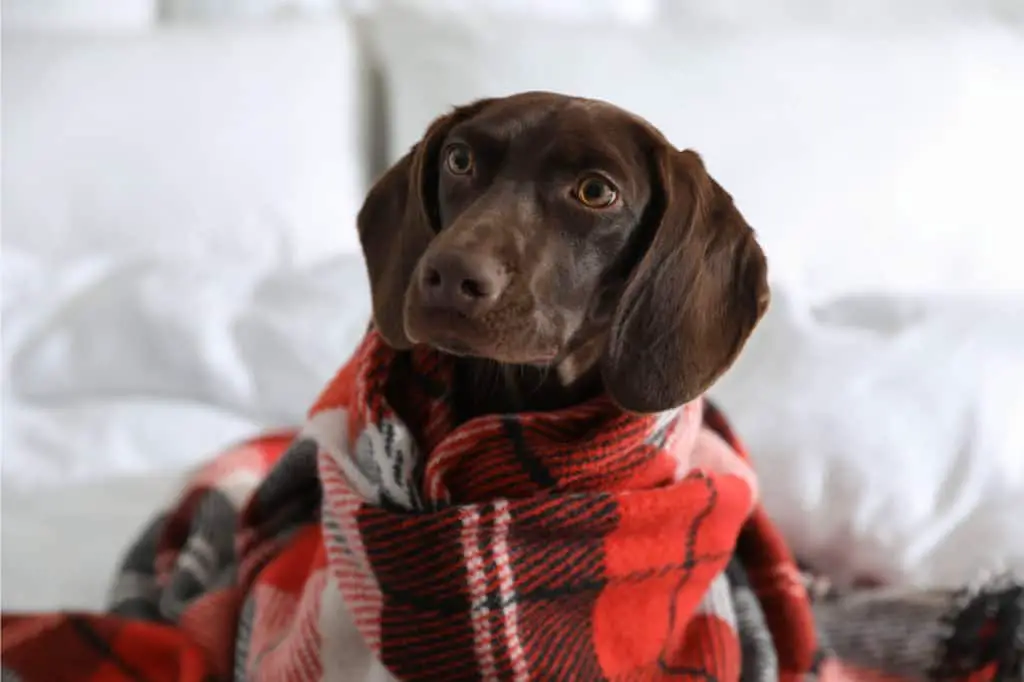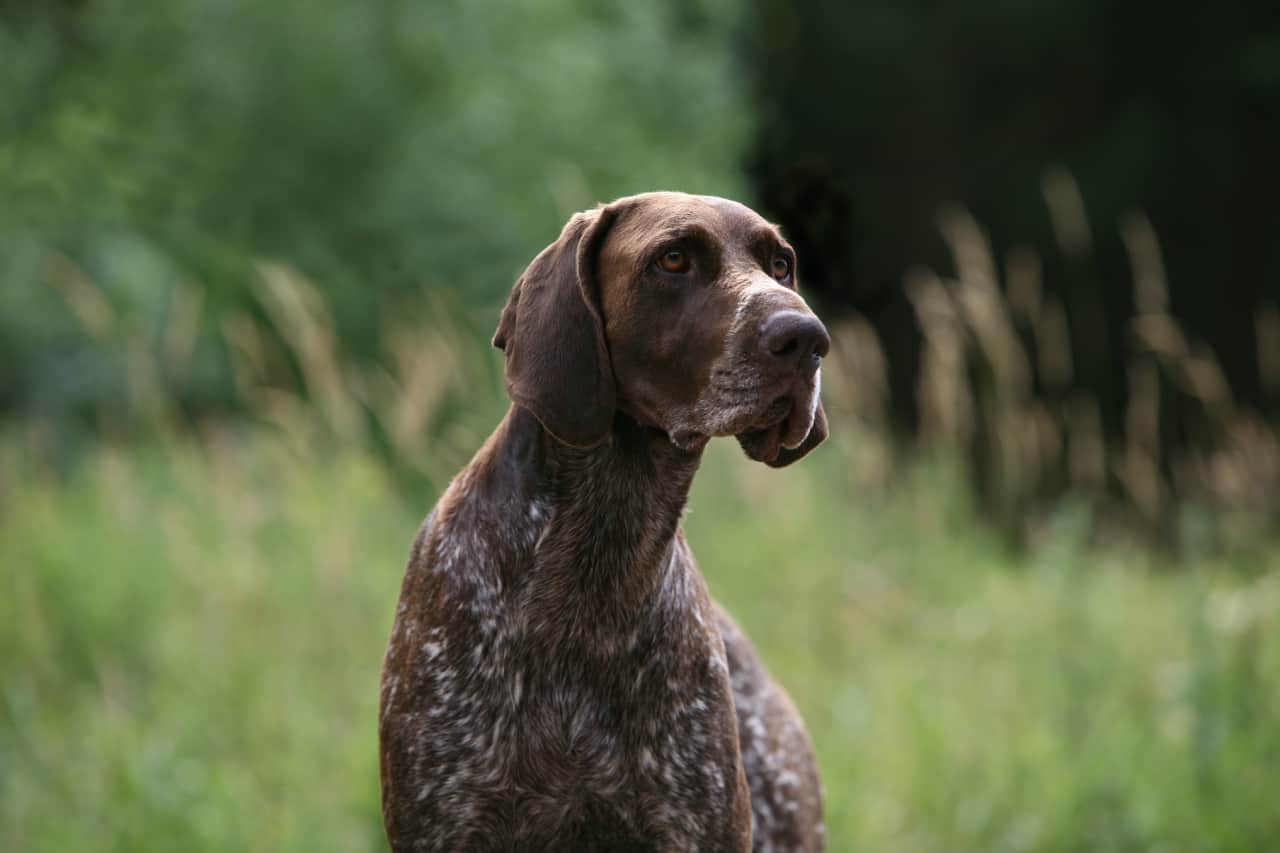The German Shorthaired Pointer is probably one of the most recognized and widely used gundogs in the field. They have a long history of being a versatile all-rounder for upland, water, and even large game hunting. Known in hunting circles as the GSP can hunt in various weather conditions and terrain and are not unaccustomed to severe weather; however, if you are an active hunter and want to use GSP as an excellent all-rounder dog, this question comes to mind. Do German Shorthaired Pointers need coats?
German Shorthair Pointers do not need coats. They are a hardy breed of working dogs and are known to be continuously active. Their short, single-haired coat is water repellant and helps keep the dog’s body temperature even when working in the field.
German Shorthair Pointers have a coat that is short and close to the body. They excel in mild climates and have a high level of stamina in the field. Every dog owner has a different outlook on the care, kenneling, and training of their respective dogs; however, there are specific characteristics of the GSP that will make the care of this particular breed unified. Let us explore further.
The German Shorthaired Pointer
To get an overall picture of the versatility and use of the GSP and why they have the coats they do, we briefly look at the breed’s origin. It developed somewhere in the mid-19th century due to Prince Albert of Hanover encouraging breeders to select various hunting specimens.
The German Bird Dog, Spanish Pointers, and some Bloodhounds were all short-coated dogs. Encouraged to breed a dog for purpose and not for aesthetics hence the German Shorthaired Pointer was born.
Today the GSP comes with a particular single-haired coat reminiscent of the founding breeds looks, abilities, and versatility. Germany gets very cold in winter, so it is easy to conclude the dogs were bred to withstand the cold and to be able to hunt un while navigating rain and snow.
The German Shorthaired Pointer Coat
The GNS has a dense short coat that only requires minimal grooming. The short coat has stiff guard hairs and is water repellent. The particular coat allows the dog to stay warm in colder weather. The GNS often sheds, so brushing once a week is sufficient. Their coats come in a few distinct colors listed below;
- Liver. The original color is considered to be liver color with white markings.
- White. A predominantly white coat with liver markings.
- White and liver. Solid background in either of the two colors with a saddle in the opposite color.
- Roan. The roan coat comes marked with or without saddles.
- Black. Although some GNS are born with black variations, the AKC regards this as a disqualifying color variant.
The head of the GNS always has a solid color; the hairs on the docked tail’s underside are slightly longer and on the haunches. The coat colorations don’t determine if a dog gets colder or warmer; however, the coat’s composition does.
Can German Shorthaired Pointers Get Cold?
German Shorthaired Pointers are hardy field dogs. They are known for their high energy levels, drive, and stamina in the field. Their short coats assist in keeping their bodies warm when needed and when they are actively working. It helps to ensure they don’t overheat. In certain instances, your GNS can get cold, and below, we examine some conditions;
- Rain. If you are working your dog in rainy weather, they will stay warm while running and hunting. As soon as they are stationary, they will become cold, dry your dog off as quickly as possible.
- Duck-blind. If you are on a duck-blind, there are bound to be lots of water retrieves. If you do not have sufficient cover in colder weather, your dog can become cold quickly.
- Excessive water work. Doing several water retrieves is acceptable; however, if you expect your dog to do a lot of water work in a day, they will get tired and lose a lot of energy, the dog will start burning fat and get cold.
- Snow. Snow will undoubtedly cause your dog to use a lot of energy reserves. Short hunting trips with rest periods in between with shelter will ensure your dog stays warm.
- Substandard diet. Feeding your working dog with the best possible diet will ensure the best performance in the field; you can adjust food slightly to the seasonal changes and exercise needs.
- Kenneling. If you are in a temperate winter region and you kennel your dogs outside, there is a good chance they might get cold if they do not have sufficient shelter from wind and rain. In areas with severe winters, it is not advisable to kennel your GSP outside.
When Is It Too Cold For Your German Shorthaired Pointer?
Generally, a German Shorthaired Pointer will become cold in temperatures below 45 degrees Fahrenheit, and care should be taken when exposing dogs to that temperature for prolonged periods.
Do German Shorthaired Puppies Get Cold Quicker?
GSP puppies are very active and burn their energy quickly. If you are outside or training in cold weather, this could cause your puppy to become hypothermic. Short bursts of exposure and training are best to ensure your puppy stays warm and interested in the activities instead of becoming lethargic.

How To Keep Your German Shorthaired Pointer Warm
Keeping your German Shorthaired Pointer warm is essential in adverse weather conditions. You can take several steps from purchasing a good hunting vest, waterproof vest, and in iced-over areas; dog boots are a great solution to keep it from slipping, cuts and abrasions, and protect against frostbite. Boots are typically worn for specific terrain and can comfortably be worn for a day’s hunt if they are a good fit. Always check your dog’s paws before and after for any debris. You can find more information on the best boots for your dog here.
How To Keep Your German Shorthaired Pointer Warm
- High-grade kibble. To keep your dog’s energy levels up, feed a kibble that has the right balance between protein and fat. You split the meal into two portions, providing the correct amount according to activity levels and body weight.
- Water. Water is essential; dogs that work hard should always have access to fresh drinking water, even on the hunting ground. Water will keep your dog hydrated and energized even in cold weather.
- Waterproof coat. If you are on a duck-blind or expect to have your do perform numerous water retrieves, an investment into a good quality waterproof neoprene jacket or vest.
- Lined vests. For upland work in icy conditions, there are several wool-lined vest or jacket options available. These jackets are not recommended for water work.
- Paw boots. These are lovely gear items to have on hand, especially if you might encounter slippery terrain, sharp rocks, or ice. These boots will help protect your dog’s paws. Start training with them from an early age as dogs need to get used to the feeling of wearing boots.
- Towel-dry. When your GSP works in cold weather, their body heat will keep them going. Should they get clammy or wet, it is a good idea to always have a small hand towel with you or a more oversized towel in your vehicle to dry the dog. Crate them as soon as they have finished working.
The German Shorthaired Pointer works well under all types of conditions unless they become too cold or overheat. Reading your dog’s body language and being mindful of the effects temperatures have on the dog will be crucial to the hunt’s success.
Will A Coat Hinder My German Shorthaired Pointer From Hunting?
A well-fitted neoprene coat for water work will greatly assist in keeping your GSP warmer while doing several water retrieves. The jacket can also protect your dog from protruding branches and sharp objects in the water. Specific jackets on the market also assist the dog in flotation and usually has a handle on the back that makes lifting your dog out of the water easy.
For dry upland work, the padded coats also come in various adjustable patterns and follow the instructions carefully to ensure a snug, comfortable fit. There is always the danger that your dog can get snagged while wearing a coat. An easy release clip is essential.
Conclusion
German Shorthair Pointers are such versatile, high-energy dogs with an even temperament. Very hard working in the field, and if not closely monitored, they can easily overexert themselves. Dogs that get cold in the working field will be much less likely to obey commands as their focus will be on getting warm and preserving their energy.
With a few simple steps and the right gear, your GNS will most likely not need an extra coat while hunting, but you will be prepared if the weather conditions require you to take action.

